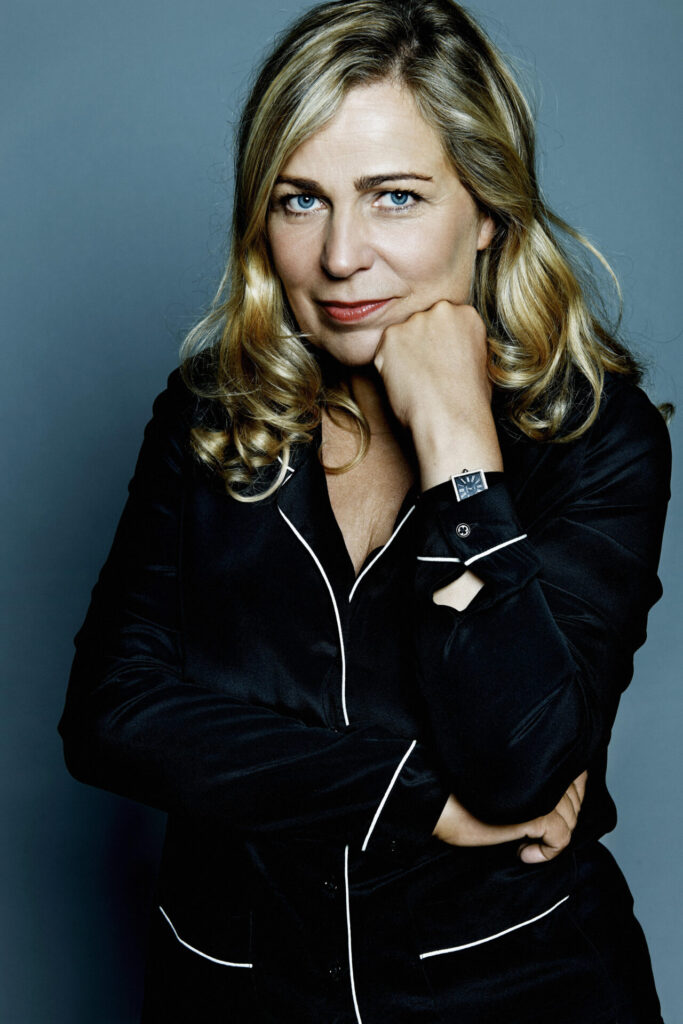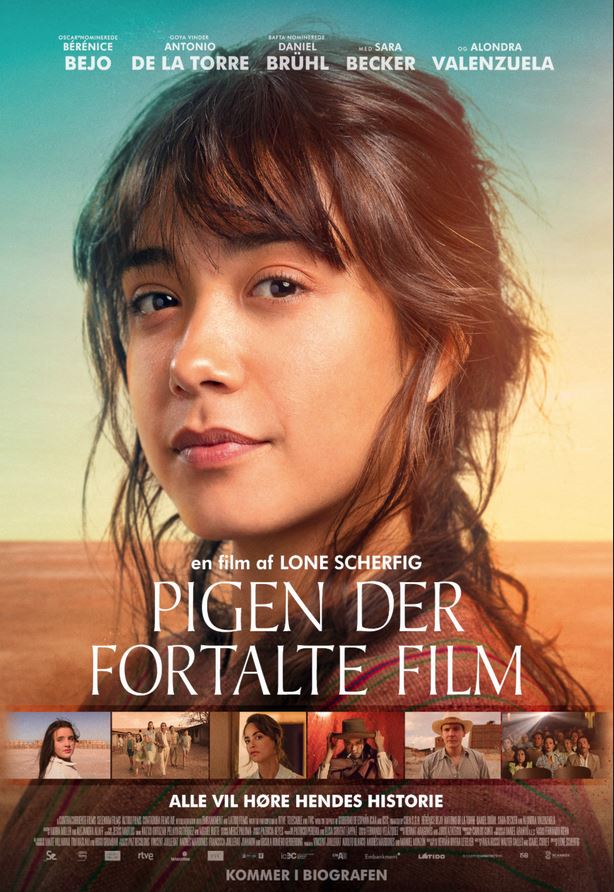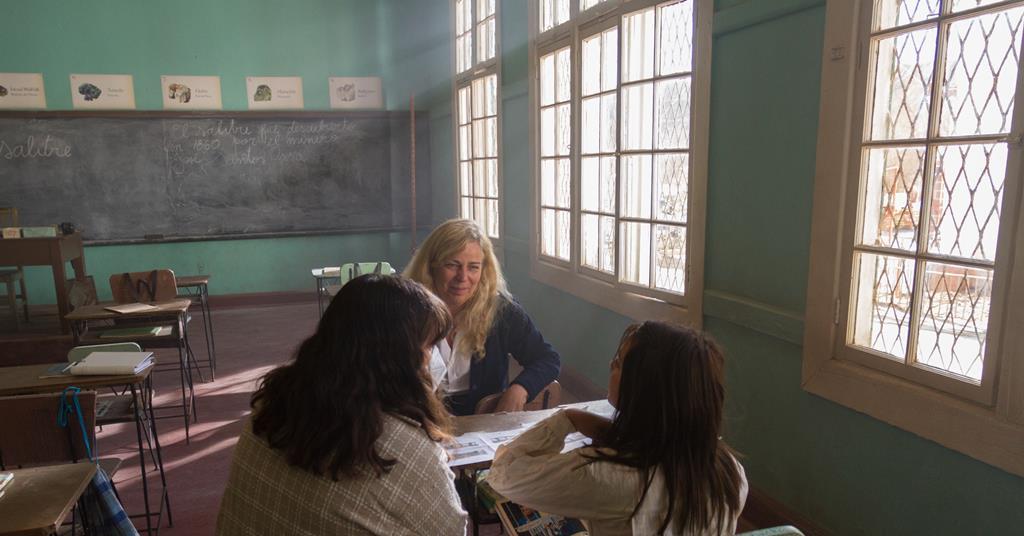A young girl goes to the movies every sunday in an impoverished Chilean saltpeter mining town in the Atacama Desert of the 1960s. Her love for movies and her ability to share them in a really enchanted and expressive way to her family and neighbors changed her life forever. This is the plot of The Movie Teller, the latest film of the danish filmmaker Lone Scherfig, that premiered at the Toronto International Film Festival in September 2023 and opened the 68th Valladolid International Film Week (Seminci) on October 21st.
The Movie Teller is based on the worldwide bestselling book by the Chilean author Hernan Rivera Letelier. The international cast includes Argentinian-born, Oscar nominated Bérenice Bejo (The Artist); German star Daniel Brühl (Rush, All Quiet on the Western Front) and Antonio De La Torre, a Goya-winning, Spanish star, as well as of course chilean actors and actresses, including the two who interpret the main character of the movie, María Margarita (played by Sara Becker and Alondra Valenzuela).
The movie was filmed in the old saltpeter mining town of Pedro de Valdivia, located in the Atacama Desert, Chile, between March and May of 2022. The Movie Teller not only tells the story of María Margarita but also the story of a world that was disappearing: the world of Chilean saltpeter miners.
Almost a year after this adventure, the Danish filmmaker agrees to this interview where she shares her experience filming, why she was so drawn to film the story of María Margarita, the subtle nuances between movies and literature, and how this project changed how she sees life and movies (Spanish version).
What did you think about the book when you read it?
I was very interested in where the book takes place (i.e. the mining towns of the Atacama Desert) . I also read another book written by Hernan Rivera Letelier, which also takes place in the Atacama. I was interested in the characters and the whole idea of the book. It’s quite short but very dense, and when I read it I wanted to stay in that world and go there.
Why did you want to stay in this world?
I’m the same age as María Margarita, and I have done a lot of films in the 60s in England, the United States, and Denmark. So as a person and filmmaker I know the period quite well, except I did not know it in Chile. So it feels like the book is also a memory of this place. And I thought it made complete sense to turn it into film because there’s so much love for cinema in the book.
How was the process of transforming the book into a script?
I read a couple of versions of the script, Walter Salles (The Motorcycle Diaries) had written one, then there was a different one where Isabel Coixet (My Life Without Me) had worked on it and a third one where Rafa Russo (Nada que perder) had worked on it, and it was with Rafa that I continued working on the script to make it more production friendly and to make it fit to the location of Pedro de Valdivia, which was not complicated because Rivera Letelier (the book’s author) has lived there. So it felt very natural to shoot it there.
How was shooting this script in a real location?
I think from when I got the job and even way into the shoot, we just constantly kept seeing if there was something we could do to make the script better, to make the production better, because there were also things we had to change during production. So it was a very organic process, which you have to do when you’re working in a real location and not a studio. You have to change the script constantly and work with the reality that you are filming in. And because of that, the film feels more authentic and natural.
This was of course fantastic for the actors, because they could go around in the actual rooms that people in the mining towns used. They could sit in the same school, classroom, the real tables and chairs. I think this has given the film something that is very unique and I also hope I stayed loyal to the book and to the world that once was.
The book and the movie is a coming of age story of a girl in a very distant land, like the Atacama Desert in Chile. Do you think this is a feminist story?
There is a scene where María Margarita promises to her mother to live a life of her own and that promise is a turning point in the film and it is definitely something that really stands out. That promise has influenced the story and also the way I have tried to understand her mother, María Magnolia, and try to make a very nuanced portrait of this woman. When you see her, which you do in the film (but don’t do in the book), you have to explain the mystery about her character a little more.
A film, in that sense, is very different from literature because you bring a character alive in a different way than you do in the book. I think the movie is an interpretation of the book and as a viewer you get a little more under the skin of the main character, María Margarita. In the book, the reader gets inside a bigger world because Rivera Letelier has not had any limitations as a writer.
Do you know if he saw the film?
I got the impression he liked the film very much. I am happy because I felt a real obligation to be loyal to the book and was very aware that I’m not Chilean.
Shooting in the desert
As an experienced filmmaker, Scherfig has shot in several countries before. “The only thing I can do is to try and learn as much as possible, but also try to ensure that the film can cross borders”, she states. In the case of The Movie Teller, she explains that she had to make sure that people who are not Chilean will understand what is going on in the background of the story because a big part of the movie happens during the regime of the Chilean dictator Augusto Pinochet. “In my part of the world, especially young people will not know what happened, unfortunately”, she explains.
What was the most fun during the process of shooting?
I had a lot of fun with the children, and I was incredibly grateful to all the people who helped restore the locations in the mining town Pedro de Valdivia, where we shot. Nobody lives there now, but it’s a place full of memories for many people.
During almost all of the 20th century, the old mining towns were located very close to the centers of saltpeter exploitation. Given the isolation and arid nature of the area, in the heart of the Atacama Desert – the driest place on the planet – the owners of the mines created almost self-sufficient enclaves in which the administration of the mining center, workers’ homes, sales centers, churches, schools, and leisure and entertainment centers were all in the same place. These towns, called “oficinas salitreras”, were home to thousands of workers from Chile, Bolivia, Peru, Europe, and the United States. But with the decline in the sale of nitrate during the 1930s, most of the nitrate offices were evicted (producing a mass exodus of workers) and dismantled. The story of María Margarita takes place when the world built around the saltpeter mines was slowly ending.
“People who inhabited that place come back every year to have a summer party, and some of them are in the film”, explains Scherfig. “So going into this time machine and being in that real world is something that means a lot to me and has changed my view of the world a lot. And I didn’t know that I was going to miss the desert so much when I left. When I sat on the plane and looked down at the Andes, it wasn’t easy to say goodbye to the Andes and the desert. It’s so strange, because I grew up close to the sea, as anyone in Scandinavia. And I can understand now that the desert somehow does some of the same to you”.
She adds: “I have the best memories. I think one of my favorites is probably the children that participated in the movie. I think that you treat your children very well in Chile, that’s what I understand. And because of that, the children are nicer, they’re very affectionate, they’re very loving. And then you love them more, and then they become more loving. It was really sad. I was really sad to say goodbye to them”.
What was the most challenging part of the shooting?
Everyday production challenges. For example, now I am working in a studio where you know everything that’s going to happen tomorrow. I think Chile is a more dramatic society in terms of the weather: There is heat, cold, earthquakes, and wind. That kind of unpredictable world that you live in is very wonderful, but it’s not as easy to shoot in, because the logistics are really tricky out in the desert. But it also gives something to the film. Actually, I would not like an American studio version of this film.
I think Chile itself has influenced the film, and then we would just try and make reality work for us. When we see the film now – and I was talking about this to the producer after our premiere – we see so many memories of things that as a crew we changed at the very last minute, because nature wanted something different, or because a car wouldn’t start, you know, a lot of small things. And now all those details, they’re all sitting there in the movie. But now it feels like that is part of the film. Like it’s something authentic. Reality had a lot of influence on the film, and that is okay
How was working with different actors and actresses and crews from different countries and backgrounds?
I’m used to working with actors who have a different background. And these actors, Antonio de la Torre is a real method actor. Bérenice Bejo is more technical. Daniel Brühl is more intellectual and works with his mind. And so they have very different access to acting. And in a way, so did the children. But the children were quite inspired by Antonio de la Torre, because they saw that his embodying Medardo (María Margarita´s father), and the way he was completely absorbed in the part, made them become more absorbed.
How was working with Chilean children?
I worked with Moira Miller, who was working closely with me and the children, she would help them and coach them. So her participation in helping the kids understand what was going on and learning the lines with them was very, very helpful for me, because my Spanish is hopeless. And sometimes I would wear a mask (because of COVID-19 sanitary restrictions), which was also tricky. I think the children are wonderful. I just don’t know. I think their acting is really, really good. And Max Salgado, also some of the adult Chilean actors. I don’t want to mention anyone because I’ll forget someone. But I mean, it feels like I’ve seen a lot of Chilean actors on the casting tapes and the standard is really high.
The Movie Teller premiered at the Toronto Film Festival. How was the experience? What were your impressions about how the movie was received?
Well, it for certain meant something to me that the film was released exactly 50 years after September 11th of 1973. That week there was so much information in the newspapers about the coup d’etat. And there were a lot of local Chilean people who live in Canada that came to see the film, which was really great.
Toronto has a very loud audience. People are really laughing and crying. That’s the tradition in Toronto. So it was wonderful for the actors to sit in the screening room and hear all these people laughing everywhere. The Toronto audience really is excellent. And one of the theaters is really big and really old and that was wonderful because the film has a lot of clips from old movies.
So I was very happy. And the reception has been good. So we are super happy and relieved. I think the next big exam is if people will like the film in Chile. Hopefully, Chilean audiences could feel that it’s their film and that it does justice to Hernan Rivera Letelier´s book and to the Atacama Desert. So there’s a lot of responsibility.
As a person, did you feel, in a way, represented by this story, by this girl who loves movies?
I also went to the cinema with my father on Sundays, and we also got dressed and put on nice clothes. And of course, the clips that we see in the film are movies that I have enjoyed in my youth. I chose films that I really love. Also, some of the family dynamics is a little bit something I recognize. But I never make films about myself. I’m much more interested in seeing something that I love and then sharing it with somebody else. In that sense, I’m more of an interpreter. I don’t want the audience to know about me. And I don’t think it’s relevant here because María Margarita’s story is much, much more dramatic than my life. So that’s one of the reasons why I prefer to work outside of Denmark, that I have this distance to what I’m making films about.
When I interviewed Hernan Rivera Letelier, he told me that the Atacama Desert was the main character of all his stories. What role does the desert play in this movie?
I think the desert is there in the background constantly, and this wall of dust that is outside in a lot of mining towns, that will eventually eat up the town. In the movie we had a “remolino” (swirl). The book does not have a remolino in the beginning but we started the film with a scene of a remolino as if the story is something the wind brought to you.
Literature is more abstract than film. So for me, it’s María Margarita who is the main character. It’s not the desert. We started and ended the movie with the desert as if you get this feeling there was a desert and in this desert there were these people, and then in the end you leave them and the camera flies away. And you feel it a lot when you’re there. The heat, the night, and especially the night sky is just unforgettable. And the most beautiful sky on the planet.
Do you have any final thoughts or commentary that you want to share?
I just wish and hope that the people who have lived this life – and all the children from Atacama who are in the film, even the writer´s granddaughter – get to see the movie and feel that this was the best film you could make out of this book. I hope the same for the people who have read all of Hernan Rivera Letelier´s books or those who want to read them. They’re wonderful.
A film is always the result of a lot of different people’s work, but when I think back I feel very grateful especially to the people who worked to restore the old mining town Pedro de Valdivia, which was a hard and tough job. I want to thank the people who put so much work into making this film and to the people who worked right next to me: My personal assistant Francisca Ponce and Moira Miller.
Marta Apablaza Riquelme is a freelance science journalist based in Santiago, Chile











